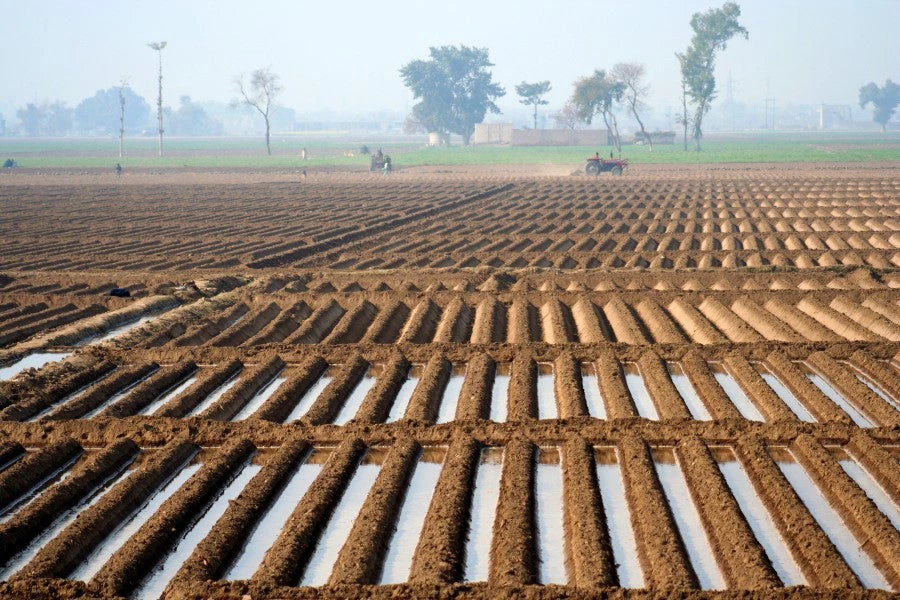 Irrigated land in Pakistan's agriculture food system
Irrigated land in Pakistan's agriculture food system
The impact of COVID-19 pandemic was particularly severe on daily wage earners and others with no employment protection. The lockdowns imposed and disruption in economic activities increased food insecurity. An estimated 50% of the population ate less or switched to lower quality food. Some 40% of the population faced moderate to severe food insecurity during April to July 2020.
The agriculture sector was also affected by lockdowns and disruptions in markets. Higher imports helped ensure consumers had ready access to key staples. For example, wheat imports reached 3.6 million tons in 2020 – a level not seen for several decades. However, markets for nutritious and perishable products such as meat, milk, fruits and vegetables proved more fragile with both producers and consumers facing difficulties.
The food system in Pakistan was able to meet the bulk of food needs during the pandemic. However, as COVID-19 retreats, conditions have not returned to normal as expected.
Shaukat Mukhtar, General Secretary of the Dairy Farmers’ Association confirms that the pandemic hit milk producers very hard, as demand dropped, transport was disrupted, and input costs increased. "Milk prices remained capped, and we got limited support from Government. Many small to medium commercial producers closed and sold off their animals, while owners of one or two animals, who sell surplus milk to meet their family cash needs could no longer do so and had to cut down expenses. The dairy herd has been cut down and will take time to rebuild,” he adds.
The crisis also accelerated several ongoing trends in the food system. Increasing numbers of wholesalers and retailers provided home delivery services; and several major supermarkets expanded their direct sourcing from farmers and local aggregators. The trend towards mechanization of farm operations also accelerated with an increased demand for machinery services and for skilled labor.
Continuing turbulence in international markets has sent food and fertilizer prices spiraling, which has highlighted the need to further transform food systems.
Post pandemic recovery
The situation improved significantly as the economy revived after general lockdowns ended on May 9 and were replaced with “Smart Lockdowns” that were much more selective and targeted. A major contributing factor in the revival was the launching of several Government assistance programs.
To support the agriculture sector Government set aside PKR 1.2 trillion for subsidies, and reduced interest rates and repayments on agricultural loans. These programs helped cushion the impact on the food and agriculture sector, but they are not reaching all farmers, especially small holders. They are also unlikely to jumpstart longer-term productivity growth as it does not address the underlying constraints in the sector such as lack of technology and support for diversification into high value products, fragmented supply chains and inefficient markets.
Building a more productive and resilient food system for all Pakistanis
The events of the past two years have demonstrated that the food system in Pakistan is able to meet the bulk of food needs during a crisis of unprecedented proportions such as that created by the COVID-19 pandemic. However, as COVID-19 retreats, conditions have not returned to normal as expected. Instead, there is continuing turbulence in international markets aggravated by the situation in Ukraine which sent food and fertilizer prices spiraling. This has highlighted the need to further transform food systems.
There is, however, heightened investor interest in agriculture. Food entrepreneurs like Sanakhawan Hussain, who moved to Hyderabad during the pandemic to manage his family banana plantation are optimistic about the future of Pakistan’s food system.
“There are many opportunities and Pakistan will see substantial transformations in the food system in the coming ten years. Government needs to make sure that it creates a favorable policy environment; works with us in the private sector to develop new technologies; and help the food system deal with shocks including climate change.”
To bring about a more resilient food system, action will be needed in the following areas:
First, Pakistan needs to address food insecurity in both rural and urban areas via multi-sectoral interventions that improve production, processing, transport, storage, and marketing. It also needs to make markets more accessible to both producers and consumers. It’s important to prioritize work on legislation, guidelines and regulations for enhanced quality control, better payments systems, and consumer protection regulations.
Secondly, Pakistan needs to empower the agriculture and livestock producers with increased use of technology to ensure broader adaption of climate-smart agriculture. Improved focus and efficiency in government expenditures are also essential to adjust the food system to higher food and energy prices.
Thirdly, the COVID pandemic highlighted the risk and impact of disease transmissions from animals to humans. Pakistan has a large stock of livestock with a substantial viral and bacterial load. This makes it particularly important for the government to take concrete steps such as enhancing vaccination campaigns against common livestock diseases, formulating improved regulations for the establishment and operations of livestock colonies, and developing institutional capacities and protocols for surveillance, monitoring, and reporting system in both rural and urban areas. The “One Health” approach launched by Government provides an excellent opportunity to take a more holistic and integrated approach to human, animal, and plant health.
Finally, Pakistan needs to encourage greater use of digital technologies in both rural and urban areas to make the food system more responsive, resilient and, efficient. Collaboration across government actors, private sector, civil society, and charitable organizations, is necessary for improving identification of vulnerable households, targeting beneficiaries of social safety nets, and monitoring effectiveness of different food security support instruments.
A more detailed policy note on building a more resilient agriculture system in Pakistan is available here.
Food insecurity among the world’s most vulnerable people is rising due to the ongoing global food crisis. As part of its response to the crisis, the Bank is supporting countries in improving agricultural productivity and building more resilient, sustainable food systems, including in Pakistan.




Join the Conversation